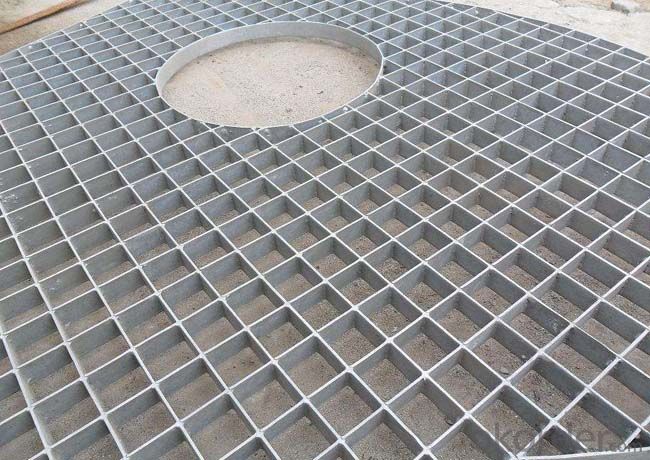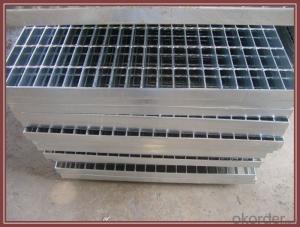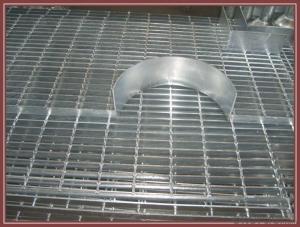Pressed And Forged Aluminum Flooring Grating/Grate/Grates
- Loading Port:
- Qingdao
- Payment Terms:
- TT OR LC
- Min Order Qty:
- 5000 pc
- Supply Capability:
- 6000000 pc/month
OKorder Service Pledge
OKorder Financial Service
You Might Also Like
1.Description of Drainage trench cover:
Drainage trench cover is widely used in the urban road, the square, the botanical garden, the wharf, the airport, the parking lot, the road, each kind of industry, the civil project, etc.
2.Main features of Drainage trench cover:
I--Carrying 20 tons of weight
II—Carrying 14 tons of weight
III---carrying 6 tons of weight
IV---carrying 2 tons of weight
V---Carrying pedestrian weight
3.Glass Wool Blanket Images:

4. Drainage Trench Cover Technical Parameters:
These drain cover plate applies to the road cross-sectional and longitudinal drain. The drains width ranging from 200mm to 550mm.
A means the steel grating length
H means the steel grating height
A means the frame length
H means the frame height
5.FAQ
We have organized several common questions for our clients,may help you sincerely:
①How about your company?
A world class manufacturer & supplier of Drainage trench cover is
one of the large scale professional investment casting production bases in China,consisting of both casting foundry forging and machining factory. Annually more than 8000 tons Precision casting and forging parts are exported to markets in Europe,America and Japan. OEM casting and forging service available according to customer’s requirement.
②How to guarantee the quality of the products?
We have established the international advanced quality management system every link from raw material to final product we have strict quality test; We resolutely put an end to unqualified products flowing into the market. At the same time, we will provide necessary follow-up service assurance.
- Q:How do aluminum profiles perform in vibration isolation applications?
- Aluminum profiles are highly effective in vibration isolation applications due to their unique properties and characteristics. The use of aluminum profiles in such applications helps to minimize and dampen vibrations, creating a stable and isolated environment. One of the primary reasons for the effectiveness of aluminum profiles in vibration isolation is their high strength-to-weight ratio. Aluminum is a lightweight material, which allows for the construction of structures that can effectively absorb and dissipate vibrations. This lightweight nature ensures that the profiles do not add excessive weight to the system, as added weight can amplify vibrations rather than dampen them. Additionally, aluminum profiles have excellent damping capabilities. Damping refers to the ability of a material to absorb and dissipate energy from vibrations. Aluminum possesses inherent damping properties, which significantly contribute to reducing vibration levels. This ensures that the profiles effectively isolate vibrations and prevent their transmission to other components or structures. Furthermore, aluminum profiles can be easily customized and designed to meet specific vibration isolation requirements. They can be engineered to have specific geometries and configurations, allowing for the creation of structures that effectively attenuate vibrations. This flexibility in design enables the optimization of the profiles for different applications and environments, ensuring maximum effectiveness in vibration isolation. Moreover, aluminum profiles offer good corrosion resistance, which is crucial in vibration isolation applications that may be exposed to harsh operating conditions. This corrosion resistance ensures the longevity and reliability of the profiles, maintaining their performance over extended periods. In summary, aluminum profiles are highly suitable for vibration isolation applications due to their lightweight nature, excellent damping capabilities, customization options, and corrosion resistance. Through their effective vibration absorption and dissipation properties, aluminum profiles help to create stable and isolated environments, minimizing the impact of vibrations on surrounding components or structures.
- Q:What are the different types of anodizing options for aluminum profiles?
- There are several types of anodizing options for aluminum profiles, including sulfuric acid anodizing (SAA), chromic acid anodizing (CAA), hard anodizing, and two-step anodizing. SAA is the most common type, providing a durable and corrosion-resistant finish. CAA offers a thinner and less durable coating, but it is commonly used for aerospace applications. Hard anodizing produces a thicker and harder coating, ideal for high-wear applications. Two-step anodizing involves an additional coloring process, allowing for a wide range of decorative finishes.
- Q:What are the different types of gaskets used with aluminum profiles?
- Aluminum profiles commonly utilize various types of gaskets. Let's explore a few examples: 1. EPDM Gaskets: Crafted from a synthetic rubber material, EPDM gaskets excel in withstanding weathering, UV radiation, and ozone exposure. They are frequently employed in outdoor scenarios that demand a secure seal and resilience against harsh environmental conditions. 2. Silicone Gaskets: Renowned for their exceptional temperature resistance, silicone gaskets are a preferred option for applications involving extreme heat or cold. They also exhibit favorable resistance to chemicals and UV radiation, rendering them suitable for a wide array of industrial and commercial uses. 3. PVC Gaskets: Composed of a plastic material, PVC gaskets are extensively used due to their remarkable resistance to chemicals, oil, and moisture. They commonly find application in situations necessitating a tight seal, such as doors, windows, and architectural uses. 4. Neoprene Gaskets: Neoprene gaskets are constructed from a synthetic rubber material that offers commendable resistance to oils, chemicals, and weathering. They are frequently employed in machinery and equipment, where both sealing and vibration dampening are required. 5. Nitrile Gaskets: Nitrile gaskets, also known as Buna-N gaskets, are composed of a synthetic rubber material that boasts outstanding resistance to oils, fuels, and solvents. They find common use in automotive and industrial settings where resistance to oil and fuel is critical. These examples are merely a snapshot of the diverse gasket options available for aluminum profiles. The choice of gasket hinges upon the specific requirements of the application, encompassing desired sealing level, environmental conditions, and chemical compatibility.
- Q:Can aluminum profiles be used for electrical applications?
- Yes, aluminum profiles can be used for electrical applications. Aluminum is a highly conductive material, making it suitable for electrical conductivity. Aluminum profiles are commonly used in electrical applications such as power distribution systems, wiring conduits, and bus bars. They provide a lightweight and cost-effective solution for electrical installations. Additionally, aluminum profiles offer good thermal conductivity, which helps in dissipating heat generated by electrical components. However, it is important to consider the specific requirements of the electrical application and ensure that the aluminum profiles meet the necessary electrical safety standards and regulations.
- Q:Aluminum bending die, iron must be used, what iron should be used, specifically what brand?
- General production of aluminum alloy is H13, die steel, if stretched or squeezed, most are carbide. I work in the production of aluminum profiles
- Q:How can I distinguish the aluminum profiles in the building and the aluminum in the industry?
- Door frames, aluminum profiles and doors and windows, aluminum profiles are in the building. Your picture is a line of scaffold material, usually in industrial material.
- Q:What are the different shapes and profiles available for aluminum profiles?
- Aluminum profiles come in various shapes and profiles, each with its own distinct characteristics and uses. Let's explore some of the most common options: 1. Square and rectangular profiles: These profiles have straight sides and sharp corners, making them perfect for applications that require strength and rigidity. They are frequently utilized in architectural structures, frames, and support systems. 2. T-shape profiles: T-shaped profiles consist of a perpendicular flange or arm extending from a larger base. They are often employed for structural purposes, providing additional strength and support in beams and columns. 3. Round profiles: Round profiles have a circular cross-section and are frequently preferred in applications that demand a smooth and seamless appearance. They are commonly found in decorative uses like handrails, lighting fixtures, and furniture. 4. Angle profiles: Angle profiles have two sides perpendicular to each other, creating a 90-degree angle. These profiles are commonly used in corner protection, edging, and framing applications. They are frequently seen in industries such as construction, manufacturing, and automotive. 5. I-beam profiles: I-beam profiles feature a central vertical web with flanges on either side, forming an "I" shape. These profiles are renowned for their high strength-to-weight ratio and are commonly used in structural applications like bridges, buildings, and heavy-duty machinery. 6. Custom profiles: In addition to the standard shapes mentioned above, aluminum profiles can also be custom-designed and extruded to meet specific requirements. This allows for endless possibilities in terms of shape, size, and functionality. In conclusion, the wide range of aluminum profile shapes and profiles enables versatility and adaptability in various industries and applications. Whether you prioritize strength, aesthetics, or a combination of both, there is an aluminum profile shape and profile that will suit your specific needs.
- Q:What are the impact resistance properties of aluminum profiles?
- Aluminum profiles have excellent impact resistance properties due to their inherent strength and durability. They can withstand high impact forces without deforming or breaking, making them suitable for various applications where impact resistance is crucial, such as automotive, construction, and aerospace industries. Additionally, aluminum profiles can absorb and distribute impact energy effectively, minimizing the risk of damage or injury.
- Q:Can Linqu aluminum profile factory have 100 home?
- Some of the largest Huajian aluminum industry in Linqu there is no doubt that there are a lot of good after scale manufacturers, such as Albert Wei Sheng Jian Zhonghao new east to east of Yangtze River following so little that it is not representative of the product but a superb collection of beautiful things, not in Linqu, most of the manufacturers is YISHION aluminum ingots as raw material, processing technology is advanced basically, can ensure the quality of products. Louzhu should mention the one hundred, because there is only a scale can reach 53 (news reports), the number of small scale is much larger than this number, so the one hundred aluminum manufacturers should be more than enough, thank you for adopting!
- Q:How do you prevent galvanic corrosion in marine environments with aluminum profiles?
- One way to prevent galvanic corrosion in marine environments with aluminum profiles is by using sacrificial anodes made of a different, more active metal. These anodes, typically made of zinc or magnesium, are connected to the aluminum profiles and act as a sacrificial material that corrodes instead of the aluminum. This helps in protecting the aluminum profiles from galvanic corrosion. Additionally, proper insulation and coating of the aluminum profiles can also be effective in preventing direct contact with other metals and reducing the risk of galvanic corrosion.
1. Manufacturer Overview |
|
|---|---|
| Location | |
| Year Established | |
| Annual Output Value | |
| Main Markets | |
| Company Certifications | |
2. Manufacturer Certificates |
|
|---|---|
| a) Certification Name | |
| Range | |
| Reference | |
| Validity Period | |
3. Manufacturer Capability |
|
|---|---|
| a)Trade Capacity | |
| Nearest Port | |
| Export Percentage | |
| No.of Employees in Trade Department | |
| Language Spoken: | |
| b)Factory Information | |
| Factory Size: | |
| No. of Production Lines | |
| Contract Manufacturing | |
| Product Price Range | |
Send your message to us
Pressed And Forged Aluminum Flooring Grating/Grate/Grates
- Loading Port:
- Qingdao
- Payment Terms:
- TT OR LC
- Min Order Qty:
- 5000 pc
- Supply Capability:
- 6000000 pc/month
OKorder Service Pledge
OKorder Financial Service
Similar products
New products
Hot products
Related keywords
































